Overview
- Brief Narrative
- Cardboard and plastic wallet that belonged to Hungarian opera singer Gabor (Gabi) Carelli. Gabor was part of an Orthodox Jewish family from Budapest. He traveled to the United State in 1939, and toured with various opera companies. His family in Hungary was persecuted by the Fascist, antisemitic government from 1940-1944; some were sent to forced labor and concentration camps. In March 1944, Nazi Germany occupied Hungary and members of his family were deported or went into hiding until Budapest was liberated by the Soviet Army in January 1945. His father was killed in a camp in 1944, but his mother, his sister, and her family came to the US in 1949.
- Date
-
emigration:
1939 February 03
- Geography
-
use:
Budapest (Hungary)
- Credit Line
- United States Holocaust Memorial Museum Collection, Gift of Peter Veres
- Contributor
-
Original owner:
Gabor Carelli
Subject: Gabor Carelli
Subject: Peter J. Veres
- Biography
-
Gabor (Gabi) Krausz was born on March 20, 1915, in Budapest, Hungary, to Jewish parents. His father, Bela Krausz, was a lawyer born on August 9, 1878, in Eger, Hungary, and his mother Lenke, was born in 1887, in Budapest. His sister Kati was born on April 16, 1911.
In 1932, he studied singing at the Franz Liszt Academy of Music and graduated in September 1933. He wanted to study in Italy under classic opera singer Beniamino Gigli, but his father insisted he train in a traditional profession as well. Gabi chose law and was admitted to the Peter Pazmany University in Budapest. He took a specialized course that allowed him to study independently while in Italy. He returned to Budapest every 6 months for exams and received his law degree in January 1936.
On November 1, 1938, he made his professional debut in La Boheme. He obtained a visiting artist’s visa and traveled to New York City with Gigli. They arrived on February 3, 1939; soon after, Gigli returned to Italy. When World War II broke out in Europe on September 1, 1939, the United States allowed visitors to stay and Gabi remained. He suffered a nervous breakdown and, due to the change in climate, lost his voice. Unable to sing, he took a job in a bookstore until his voice returned.
Gabi toured the United States with various opera companies throughout the 1940s, performing under the stage name Gabor Carelli. In 1944, he returned to New York and joined the Salmaggi Opera Company. He made 2 trips back to Budapest in September 1947, and April 1948, to visit his family and perform with the Budapest Opera. On June 20, 1950, Gabi became a U.S. citizen and officially changed his name to Carelli. He joined the metropolitan Opera in 1951. In 1966, he joined the faculty of the Manhattan School of Music where he taught voice and ensemble. He returned to Budapest in the summers to teach at the Academy of Music and give radio lectures. He retired from singing in 1974.
Bela died in an internment camp in 1944 at 66. Kati and Lenke emigrated to the United States in 1949. Lenke died in 1968 at 81, and Kati in 1994 at 83, both in New York City. Gabi continued to teach until his death on January 22, 1999, at 83.
Peter Jaos Veres was born on October 23, 1938, in London. His father George, a businessman, was born on September 7, 1906, and his mother, Kati, was born on April 16, 1911, both in Budapest, Hungary. On March 13, 1938, Nazi Germany annexed Austria and news of Jewish persecution filtered into Hungary. Kati was pregnant at the time. George decided the baby would be born in England so he would have a British passport and not be identified as a Hungarian Jew. On August 24, Kati left for London; George arrived in October. After the child, Peter, was born, he was baptized as an Anglican and the family returned to Budapest on November 11.
On March 19, 1944, German forces occupied Hungary and anti-Jewish decrees were put in place; Jews had to wear Star of David armbands, move into designated buildings, and deportations to concentration camps began. Since 1939, George had been in and out of forced labor camps and after the German invasion he was interred at a camp in Budapest. On May 3, 1944, apartments and houses belonging to Jews were registered and labeled with a yellow star. Peter, his mother, and grandmother Lenke moved in with his paternal grandparents on May 11. During bombing raids, the family would hide in the basement. His brother, Paul, was born on June 21, 1944, in Budapest. By June 23, all Jews had to move into yellow star buildings, one family per room. The Veres apartment was not in a yellow star building, and they had to move in with a family friend. Peter, being under six years old, was not required to wear a yellow star. Every morning he walked to the corner to buy milk for his baby brother, and his mother watched him from their apartment balcony to make sure he was safe.
Peter, as a British national, was under the protection of the Swiss consulate. George arranged for Peter to live with two Swiss Catholic women, Elizabeth Baeriswyl and her niece, Mimi. Peter left his mother on October 16, 1944, and stayed with them for three months. During that time he posed as a relative, went to church, and attended Sunday school. His father would periodically escape from his labor camp and arrange to see Peter in a public place. They would not speak, just have visual contact. On November 3, 1944, Kati, Lenke, and Peter went into hiding; George escaped from the camp on December 12, 1944, and hid in a Swiss emergency hospital. On January 14, 1945, Pest was liberated by the Soviet army and Peter was reunited with his family.
After liberation, the Veres family and Lenke decided to leave Hungary. In January 1949, they left Budapest for Milan, Italy. They sailed on the M/S Sobieski from Genoa, Italy, for the United States. Lenke stayed in Italy and sailed on a later date. On ship, Peter played shuffleboard and watched American movies. They arrived in New York City on March 29, 1949. They spent the night on Ellis Island and officially entered the U.S. on March 30. Due to the Displaced Persons Act passed on June 25, 1948, the family was able to obtain Permanent Residency Cards and remain in the U.S. Peter, as a British national, was considered an alien and did not fall under the protection of the Act. He had to go to Canada and reenter the U.S. under a different visa. On June 8, 1959, he became a U.S. citizen.
He moved to California, married, and had 2 children. George died on February 1, 1967, at age 67, Lenke on December 2, 1968, at 81, and Kati on February 20, 1994, at 82, all in Manhattan.
Physical Details
- Classification
-
Dress Accessories
- Category
-
Carried dress accessories
- Object Type
-
Wallets (lcsh)
- Physical Description
- Rectangular light brown stiff cardboard pocket with clear plastic center inserts, a u-shaped depression at the open top, and metal edging on the sides and bottom.
- Dimensions
- overall: Height: 3.750 inches (9.525 cm) | Width: 4.750 inches (12.065 cm) | Depth: 0.125 inches (0.318 cm)
- Materials
- overall : plastic, cardboard, metal
Rights & Restrictions
- Conditions on Access
- No restrictions on access
- Conditions on Use
- No restrictions on use
Keywords & Subjects
Administrative Notes
- Legal Status
- Permanent Collection
- Provenance
- The plastic badge holder was donated to the United States Holocaust Memorial Museum in 2010 by Peter Veres.
- Funding Note
- The cataloging of this artifact has been supported by a grant from the Conference on Jewish Material Claims Against Germany.
- Record last modified:
- 2023-06-13 16:10:40
- This page:
- https://collections.ushmm.org/search/catalog/irn47179
Also in Peter Veres family collection
The collection consists of artifacts, audio recordings, documents, film, and photographs relating to the experiences of the Deutsch, Krausz, and Veres families in Budapest, Hungary, prior to and during the Holocaust, when some family members were deported to camps or lived in hiding, and after their postwar emigration to the United States.
Date: 1844-2010
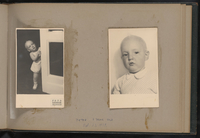
Peter Veres family papers
Document
The Peter Veres family papers consist of family records, photographs, genealogical materials, immigration documents, and reparations records documenting the history of a Jewish family in Budapest, their experiences with labor camps, hiding, and deportations during World War II and the Holocaust, and their immigration to New York in 1949. The Kato Krausz Veres materials include birth and marriage certificates, identification papers, an account book, education records, health records, an obituary, and other material documenting Kati’s childhood in Budapest, experiences in Hungary during the 1930s and 1940s, religious conversion, immigration to the United States, and death in 1994. This series also includes letters Kati wrote to her parents in October 1938 while she was in London for Peter’s birth, an identification document for Kati’s son, Peter Veres, and an obituary for her sister in law, Agnes Hardy. The George Veres materials include birth certificates, childhood letters, identification papers, education records, labor camp records, health records, an obituary, and other material documenting George’s childhood in Budapest, his operation of a Goodyear store in Budapest, experiences in forced labor during the war, religious conversion, immigration to the United States, and death in 1974. The Béla Krausz materials include birth and marriage records, school records, military papers, life insurance records, and correspondence documenting Béla’s birth in Eger, legal education and practice, marriage to Lenke Deutsch, military service, and internment before his deportation and death. The Lenke Deutsch Krausz materials include identification papers, an account book, date books, journals, correspondence, education records, Budapest property records, emigration records, a death certificate, and obituaries documenting Lenke’s childhood in Budapest, experiences in Hungary during the 1930s and 1940s, immigration to the United States, and death in 1968. This series also includes obituaries and other materials about her parents Vilmos and Irene Deutsch, brother Laszlo Danos, and relative Emanuel Müller. The Gabor Krausz Carelli materials include birth certificates, identification papers, education and financial records, address and date books, immigration records, news clippings, correspondence, and other material documenting Gabor’s childhood in Budapest, immigration to the United States in 1939, and his family’s efforts to contact him during the war. This series also includes awards, opera posters, programs, publicity records, schedules, and USO correspondence documenting Gabor’s singing career in Italy, the United States, and Hungary. The Ármin and Sári Veres materials include birth certificates, identification papers, love letters, marriage records, death announcements, photographs of Sári’s funeral and the Veres’ tombstones, and other material documenting the Veres’ lives in Hungary. This series also includes records documenting Veres and Hajossy relatives including Albert and Fani Hajossy, Fanni Hegedus Hercz, Salamon Löwy, Samuel and Marton Roth, and Jacob, Markus, and Moricz Schiff, as well as research into Schiff and Hajossy family history. Photographic materials include seven family photo albums, one of which was dismantled at some point, documenting the Vilmos Deutsch and Irene Müller family, Lajos Krausz and Linka Klein family, Ármin Veres and Sári Hajossy family, Béla Krausz and Lenke Deutsch family, and George Veres and Kati Krausz family. The albums primarily include photographs of family members, but some also include additional photographs and documents. For example, the Vilmos Deutsch and Irene Müller family album includes the couple’s 1917 passports, 1986 photographs of a silver menorah, and photographs of the buildings in Budapest that used to be the Deutsch family apartment, Kati’s school, and Goodyear store operated by George Veres. The Lajos Krausz and Linka Klein family album includes family trees and childhood letters from the Krausz children to their parents. The Béla Krausz and Lenke Deutsch family album includes marriage documents and bookplates, and the “Kató and Gabi growing up” album includes documents and photographs related to Beniamino Gigli. Genealogical materials include family trees, family history, and unidentified 19th century Hebrew materials documenting the Deutsch/Müller family, the Krausz family, the Roth/Veres family, and the Schiff/Hajossy family. Immigration documents include letters Peter Veres’ family sent to Sári Veres from Italy after leaving Hungary and preparing to immigrate to the United States and records documenting the family’s immigration and naturalization process in America. These files also include records documenting the family’s registration as refugees in Italy and records documenting alternative plans to emigrate to Canada or Costa Rica. Reparations records include correspondence, forms, affidavits, and payment notifications documenting the Veres family’s efforts to receive reparations for Béla Krausz’s death, George Veres’ forced labor, and the theft of valuables.
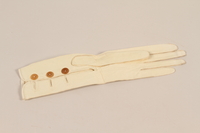
Pair of white leather Masonic gloves with button cuffs owned by a Hungarian Jewish emigre
Object
White leather ceremonial gloves that originally belonged to Vilmos Deutsch. They were acquired through his membership in the Freemason society. White kid gloves were presented to newly initiated members; a man's pair for the member and a woman's pair for his wife or betrothed. They were symbolic and not intended for use and represented the ideal that the work of his hands should be pure and spotless. Vilmos, who died in 1935, was from a large, Orthodox Jewish family in Budapest, Hungary. The gloves were inherited by his daughter, Lenke. In March 1944, Hungary was occupied by Nazi Germany. Lenke's husband, Bela, was deported in July to a concentration camp where he was killed. In November, Lenke went into hiding with her daughter Kati and her children, and her son-in-law’s family. The city was liberated by Soviet forces in January 1945. Lenke brought the gloves with her when she left Hungary with Kati and her family in January 1949 for the United States.
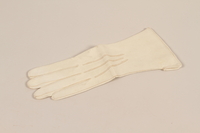
White leather wrist length left hand Masonic glove with side vent owned by a Hungarian Jewish emigre
Object
White leather ceremonial left hand Masonic glove that originally belonged to Laszlo Danos, born Deutsch. It was acquired through his membership in the Freemason society. White kid gloves were presented to newly initiated members; a man's pair for the member and a women's pair for his wife or betrothed. They were symbolic and not intended for use; they represented the ideal that the work of his hands should be pure and spotless. Laszlo, who died of a heart attack in 1934, was part of a large, Orthodox Jewish family in Budapest, Hungary. His wife gave the glove to his sister Lenke. In March 1944, Hungary was occupied by Nazi Germany. Lenke's husband, Bela, was deported in July to a concentration camp where he was killed. In November, Lenke went into hiding with her daughter Kati and her children, and her son-in-law’s family. The city was liberated by Soviet forces in January 1945. Lenke brought the gloves with her when she left Hungary with Kati and her family in January 1949 for the United States.
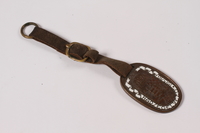
WWI Hungarian War Supporter copper watch fob acquired by a Jewish army veteran
Object
World War I Hungarian War Supporter copper watch ornament originally owned by Bela Krausz, issued for contributions to military aid for the year 1915/16. Bela, an Orthodox Jew and WWI veteran, was arrested in Budapest on May 31, 1944, following the occupation of Hungary by Nazi Germany on March 19. He was deported in July to an unknown concentration camp where he was killed. In November, his wife Lenke went into hiding with their daughter Kati and her children, and her son-in-law’s family. The city was liberated by Soviet forces in January 1945. Lenke brought the watch fob with her when she left Hungary with Kati and her family in January 1949 for the United States.
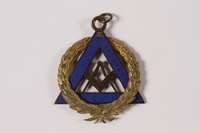
Gold and blue enamel Masonic medal with the compass and square emblem owned by a Jewish Hungarian emigre
Object
Square and compass Masonic medal that originally belonged to Armin Veres, born Roth. It was possibly a sign of office for a Senior Deacon in the Galilei Freemason Lodge in Budapest, Hungary. Armin, a lawyer, lived in Budapest with his family. On March 19, 1944, Nazi Germany occupied Hungary and antisemitic laws went into effect. The apartments of many Jews were confiscated and several family members moved in with Armin and his wife, Sari. By June 23, all Jews were forced to move into segregated yellow star buildings and they moved in with a family friend. In November, Armin and Sari were sent to the ghetto, and their children went into hiding. The Soviet Army liberated Pest on January 14, 1945, and Armin and Sari were reunited with their family. Armin died April 1, 1945. The collar was brought to the United States by his son, George, when he emigrated in March 1949.
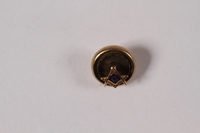
Masonic tie pin with a gold compass and square emblem owned by a Hungarian Jewish emigre
Object
Gold and dark blue enamel Freemason tie tack belonging to Armin Veres, born Roth. He was a member of the Galilei Freemason Lodge in Budapest, Hungary. Armin, a lawyer, lived in Budapest with his family. On March 19, 1944, Nazi Germany occupied Hungary and antisemitic laws went into effect. The apartments of many Jews were confiscated and several family members moved in with Armin and his wife, Sari. By June 23, all Jews were forced to move into segregated yellow star buildings and they moved in with a family friend. In November, Armin and Sari were sent to the ghetto, and their children went into hiding. The Soviet Army liberated Pest on January 14, 1945, and Armin and Sari were reunited with their family. Armin died April 1, 1945. The collar was brought to the United States by his son, George, when he emigrated in March 1949.
Oral history interview with Catherine (Kati) Veres
Oral History
Freemason white knit cotton gloves presented to a Hungarian Jewish emigre
Object
Pair of white cotton knit gloves presented to George Veres when he became a member of a New York chapter of the Freemasons in 1950-1951. White gloves, usually kid leather, were presented to newly initiated members. They were symbolic and not intended for use and represented the ideal that the work of his hands should be pure and spotless. George emigrated from Hungary to the United States with his family in March 1949. In 1940, George, who was Jewish, was sent to a forced labor camp by the Fascist, antisemitic government of Hungary. From 1940-1944, he was in and out of camps near Budapest. In March 1944, Nazi Germany occupied Hungary. That November, George's wife, Kati, and their two young sons, Peter and Paul, went into hiding. On December 12, 1944, George escaped his camp and found refuge in a Swedish emergency hospital. Pest was liberated by the Soviet Army on January 14, 1945, and George was reunited with his family. In January 1949, the family emigrated to the United States.
Ceremonial Masonic blue and white ribbon collar owned by a Hungarian Jewish emigre
Object
Ceremonial blue and white ribbon collar that originally belonged to Armin Veres, born Roth. It was acquired through his membership in the Galilei Freemason Lodge in Budapest, Hungary. Armin, a lawyer, lived in Budapest with his family. On March 19, 1944, Nazi Germany occupied Hungary and antisemitic laws went into effect. The apartments of many Jews were confiscated and several family members moved in with Armin and his wife, Sari. By June 23, all Jews were forced to move into segregated yellow star buildings and they moved in with a family friend. In November, Armin and Sari were sent to the ghetto, and their children went into hiding. The Soviet Army liberated Pest on January 14, 1945, and Armin and Sari were reunited with their family. Armin died April 1, 1945. The collar was brought to the United States by his son, George, when he emigrated in March 1949.
Oral history interview with Peter Veres
Oral History
Peter Veres discusses his family’s arrival at Ellis Island in March 1949 and history in Hungary and New York.




